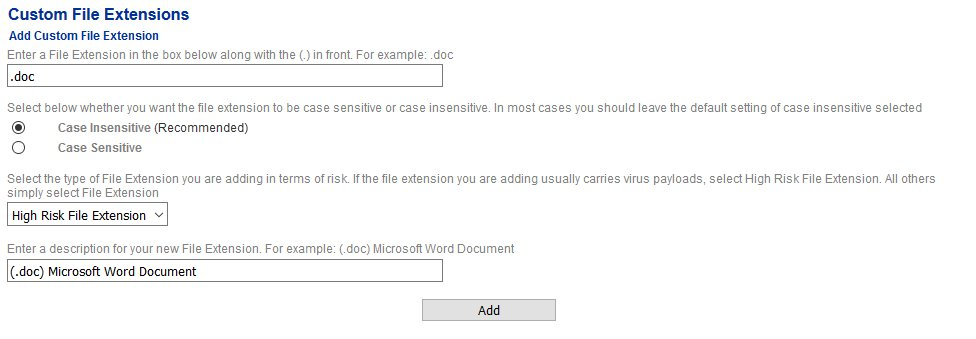Custom File Extensions
File Extensions are helpful in identifying files contained in incoming email attachments. File extensions are used in File Rules which in turn are used in Spam/Virus/File Policies. Utlimately Spam/Virus/File Policies are assigned to Internal Recipients in order to block or allow incoming email attachments on a per recipient basis.
Hermes SEG comes already pre-configured with dozens of file extensions but it's impossible for the existing File Extensions to encompass every possible file in existence. In this page, you can add or delete additional File Extensions as required.
Add Custom File Extension
- In the Add Custom File Entension section, under the Enter a File Extension in the box .... field, enter the file extension you wish to add, ensuring you enter a (.) dot in front of the extension. For example, if you were adding the file extension for Microsoft Word document you would enter .doc.
- Under the Select below whether you want the file extension to be case sensitive or case insensitive ....select either Case Insensitive or Case Sensitive. It's recommended that you always select the Case Insensitive option unless you have a specific reason not to.
- Under the Select the type of File Extension you are adding in terms of risk... select either File Extension or High Risk File Extension. The High Risk File Extension option should be selected for File Extensions that are prone to carrying malware payloads.
- Under the Enter a description for your new File Extension... enter a brief description.
- Click the Add button (Figure 1).
Figure 1
- As you add Custom File Extensions, they will show up under the Delete Custom File Extensions section (Figure 2).
Figure 2
Delete Custom File Extension
Note: If a file extension is part of a file rule, the system will NOT allow you to delete it. If that's the case, the file extension must first be removed from the file rule under Content Checks --> File Rules.
- Under the Delete Custom File Extensions section, select the File Extension entry you wish to delete and click the Delete button (Figure 3). Note that only one entry can be selected at a time.
Figure 3



